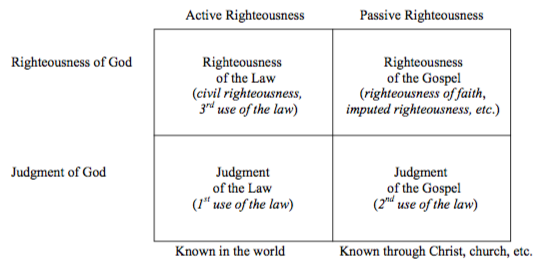By Martin Lohrmann
International Crossings Conference – January 2014
Belleville, IL
Outline of the Work
Introduction and Overview
1. Pluralism in the United States
2. The Medieval Context: Western Christendom
3. The Reformation as an Age of Confessionalization
4. The Three Estates:
Household
State
Church
5. The Two Kinds of Righteousness, Squared (See charts 1 & 2 on the back of this page)
“I [Luther] did not know that through the preaching and the Holy Scripture of Christ’s church there was a twofold judgment of God, one of the law and another of the gospel, and likewise a twofold righteousness of God, one of the law and another of the gospel. In the world the judgment and righteousness of the law is known, but it is not performed; but – as the prophets announced – David’s son, our Lord Jesus Christ, would bring about the judgment and righteousness of God through the gospel when he was upon the earth, as in Jeremiah 23[:5]: “He will make judgment and righteousness on the earth, etc.”1
5a. The Righteousness of the Law 5b. The Judgment of the Law
5c. The Judgment of the Gospel
5d. The Righteousness of the Gospel
6. Crossing Religious Diversity in the Wittenberg Tradition
- External difference
- The desire to control
- The desire to be lords
- The freedom to be the Lord’s
- The freedom to let others be the Lord’s
- The freedom to serve unconditionally
1 Cited in Martin Lohrmann, Bugenhagen’s Jonah (Minneapolis: University Lutheran Press, 2012), 125.
Chart 1: The Two Kinds of Righteousness, Squared
Chart 2: The Benefits of the Two Kinds of Righteousness, Squared





You must be logged in to post a comment.